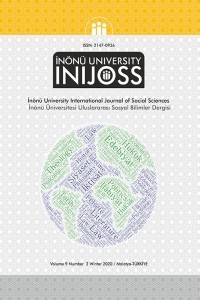SOSYAL MEKANLARDA MEDYA KULLANIMI VE KAMUSAL GÜNDEM
Kamusal alan hüviyeti taşıyan mekanlar, anlam üretme mekanizmaları olarak işlev görmektedirler. Anlam üretme mekanlarına ilişkin farklılıklar ve mekanı kullananların medya ile ilişkileri ölçüsünde medyanın anlam üretimindeki rolü, bu çalışmada, Türkiye’deki geleneksel kahvehaneler ile modern kafelerin örneğini oluşturan Sturbucks’lar üzerinden incelenmektedir. İki kamusal mekanın kendine özgü yapısının, bu iki mekanı tercih eden insanların demografik özelliklerinin ve medyayla ilişkilerindeki farklılaşmaların tespit edilmesi çalışmanın temel amacıdır. Bu bağlamda iki farklı kamusal alanın ve bu alanda bulunan insanların medyayla ilişkilerini, medyanın iki ayrı mekana ait insanların gündemini ne ölçüde belirlediğini, farklılıkları anlamak üzere gerçekleştirilen çalışma Kayseri'deki, kahvehane ve yeni nesil kafelerde yapılmıştır. Mekan, insan ve iletişim teknolojileri üçgeninde modern yaşamla birlikte belli oranda değişime uğramış ya da değişime direnmiş olgular olarak ortaya çıkan geleneksel kahvehaneler ve modern yaşamın toplanma yerlerinden olan Starbucks tarzı dükkanlar, sosyal ortamlar açısından bu araştırmanın inceleme basamağını oluşturmaktadır. Araştırmanın diğer boyutlarını ise adı geçen iki ayrı mekanda vakit geçiren insanlar ve bu insanların kullandıkları iletişim araçlarından aldıkları mesajlar ve etkileri bağlamında ayrımlarının incelenmesi oluşturmaktadır.
Bu bağlamda görece geleneksel mahalle kahvehanelerinde ve şehrin daha çok hareketli noktalarında konuşlanan modernliğin temsili Starbucks’larda zamanını geçiren
insanların, iletişim teknolojileri ve medyayla ilişkilerini anlamak üzere çalışmada gözlem ve yarı yapılandırılmış mülakat tekniği kullanılmıştır. Araştırma sonuçları, kahvehane ve yeni nesil kahve dükkanlarını tercih etmede, insanların demografik özelliklerinin belirleyici nitelik taşıdığını gösterirken, medyanın da sosyal medya ve geleneksel medya şeklinde mekana göre farklılaşmak üzere, her iki kamu mekanında, kamusal gündemi belirleyen araç olarak etkin konumda olduğunu ortaya koymaktadır.
Social Spaces and Agenda: A Review of Traditional and New Generation Coffeehouses
Spaces that have the identity of public spaces function as mechanisms of meaning production. Under the study, the differences between spaces for producing meaning and the role of the media in the production of meaning to the extent of the relationships of space users with media are examined through the example of traditional coffee shops and Starbucks as an example of modern coffee shops in Turkey. The main purpose of this study is to determine the distinctive structure of the two public spaces, the demographic characteristics of the people who prefer these two spaces, and the differences in their relations with the media. In this context, the study was carried out on the coffeehouses and new generation of coffee shops in Kayseri Province in order to understand the two different public spaces, and the relations of the people in this area with the media and the extent to which the media determines the agenda of the people belonging to two
different places and the basic differences.
Traditional coffeehouses, which emerged as events that have changed or resisted to a certain extent modern life in the triangle of space, human and communication technologies, and Starbucks-style shops, which are among the meeting spaces of modern life, constitute the examination step of this research in terms of understanding and interpreting the social environments. The other dimensions of the study consist of the people who spend time in two different places and the messages they receive from their communication tools and of examining their differences occurred in terms of effects. In this context, the method of observation and semi- structured interview technique was used in the study carried out to understand the communication technologies and media relations of the people who spend their time in the relatively traditional neighborhood coffeehouses and Starbucks, which represent the modernity and is located in the
more active points of the city. The results of the research show that both public spaces have an effective position as a tool to determine public agenda as media differentiates according to the space in the using form of social media and traditional media, while the demographic characteristics of the people have decisive features to choose coffeehouses and new generation of coffee shops.
___
- blog.nyhistory.org., 2018 http://blog.nyhistory.org/alice-foote-macdougall-queen-of-the-coffee-shop/ [available date: 13 09 2019].
- Anon., 2018. From the stacks. [Online] Available at: http://blog.nyhistory.org/alice-foote-macdougall-queen-of-the-coffee-shop/ [Accessed 13 09 2019].
- Anon., n.d. Tarihçe. [Online] Available at: http://www.starbucks.com.tr/about-us/our-heritage/ [Accessed 13 09 2019].
- Foucault, M., 2014. Başka Mekanlara Dair. In: Özne ve İktidar. 4 ed. İstanbul: Ayrıntı Yay, p. 299.
- Goffman, E., 2014. Günlük Yaşamda Benliğin Sunumu. İstanbul: Metis Yay.
- Habermas, J., 2015. Kamusal Alan. In: M. Özbek, ed. Kamusal Alan. İstanbul: Hil Yay., p. 95.
- Keane, J., 2002. Kamusal Alanın Yapısal Dönüşümleri. In: S. İrvan, ed. Medya Kültür Siyaset. Ankara: Alp Yay., pp. 312-313.
- Öztürk, S., 2006. Cumhuriyet Türkiyesi'nde KAhvehane ve İktidar 1930-1945. İstanbul: Kırmızı Yay.
- Schultz, H., Yang, D. J., 2011. Starbucks: Gönlünü İşine Vermek. 3 ed. İstanbul: Babıali Kültür Yay.
- Sennett, R., 2013. Kamusal İnsanın Çöküşü. 4 ed. İstanbul: Ayrıntı Yay.
- Yıldız, C., 2007. Kahvehane Kültürü. İstanbul: Beyan Yay.
